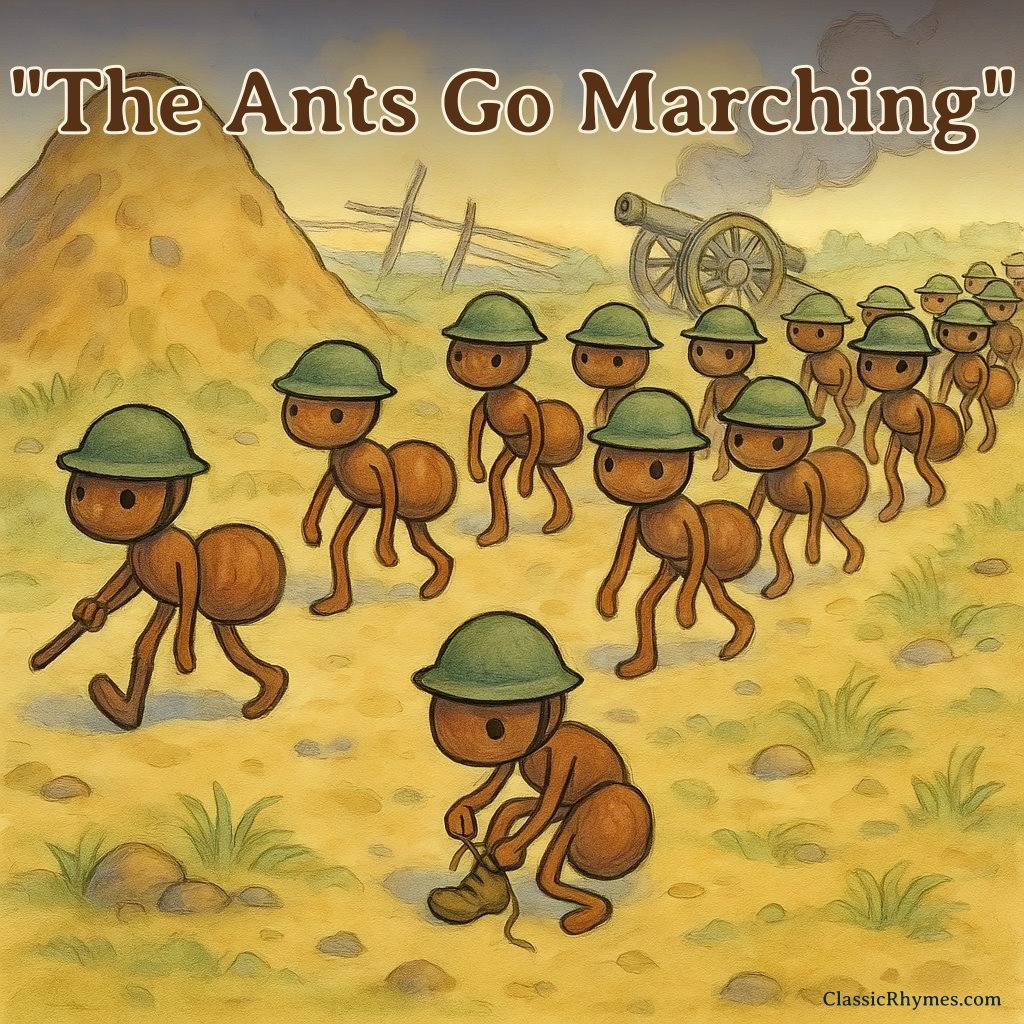The Ants Go Marching 🐜
This rhyme imaginatively follows the movement pattern of ants, with each verse featuring ants “marching” in numbers from one to ten, accompanied by humorous actions taken by the smallest ant. The rhythm and repetitive structure make it a fun and engaging nursery rhyme, often used for children’s entertainment and learning.
The ants go marching one by one, hurrah, hurrah
The ants go marching one by one, hurrah, hurrah
The ants go marching one by one, the little one stops to suck his thumb.
And they all go marching down to the ground
To get out of the rain, BOOM! BOOM! BOOM!
The ants go marching two by two, hurrah, hurrah
The ants go marching two by two, hurrah, hurrah
The ants go marching two by two, the little one stops to tie his shoe.
And they all go marching down to the ground
To get out of the rain, BOOM! BOOM! BOOM!
—
(The pattern continues through ten, with fun rhymes such as The little one stops to: climb a tree, shut the door, take a dive, pick up sticks, pray to heaven, shut the gate, check the time, and shout “The End!”)
Print or Save This Rhyme
Download PDFRecitals
Listen as male American:
Listen as female American:
What is the Meaning of ‘The Ants Go Marching’ Nursery Rhyme?
“The Ants Go Marching” is a popular children’s counting and marching rhyme. It helps children learn numbers from one to ten through a repetitive and engaging song. The ants represent teamwork and community, marching in unison to accomplish a common goal. It encourages counting, rhythm, and cooperative play, making learning fun and interactive.
History and Origin of the Rhyme
Origin
The tune is derived from the American Civil War song “When Johnny Comes Marching Home” written by Patrick Gilmore in 1863. The nursery rhyme adapted this melody and transformed it into a lighthearted children’s song, replacing soldiers with ants.
Time Period
The rhyme was popularized in the 20th century but is based on a much older melody and themes from the mid-19th century.
Historical or Cultural Notes
The melody’s Civil War origins contrast with the playful children’s rhyme it inspired. It remains widely used in classrooms and children’s music worldwide.
Why It Became Popular
Its catchy and repetitive structure makes it easy for children to memorize. The combination of counting, music, and fun actions has made it a staple in early childhood education and group activities.
Notable Variants
Some versions adapt actions or end the count at different numbers; others change the rhymes for the little one’s activities.
Structure, Style, and Themes
Structure and Style
- Meter: Marching rhythm, repetitive
- Rhyme Scheme: Alternating rhymes (AABB)
- Line Count: Six lines per verse
- Style Notes: Counting rhyme, action song, playful
Themes
- Counting and numbers
- Teamwork and cooperation
- Rhythm and movement
- Childhood play and learning
Language Notes
Uses simple, repetitive language ideal for young children to learn counting, basic verbs (stop, march), and body actions (suck thumb, tie shoe).
Moral or Lesson
Promotes cooperation, counting skills, and physical participation through rhythm and movement.

